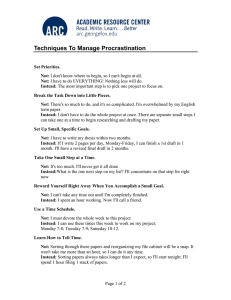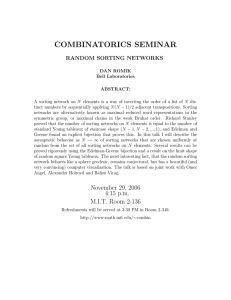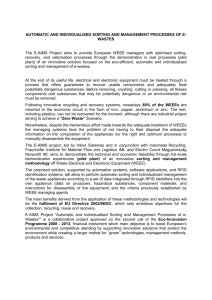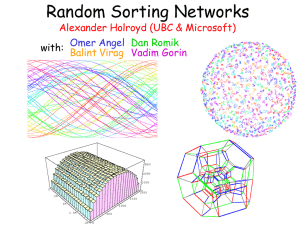NSERC USRA Report- Random Sorting Networks Jeremy Hoskins University of British Columbia
advertisement
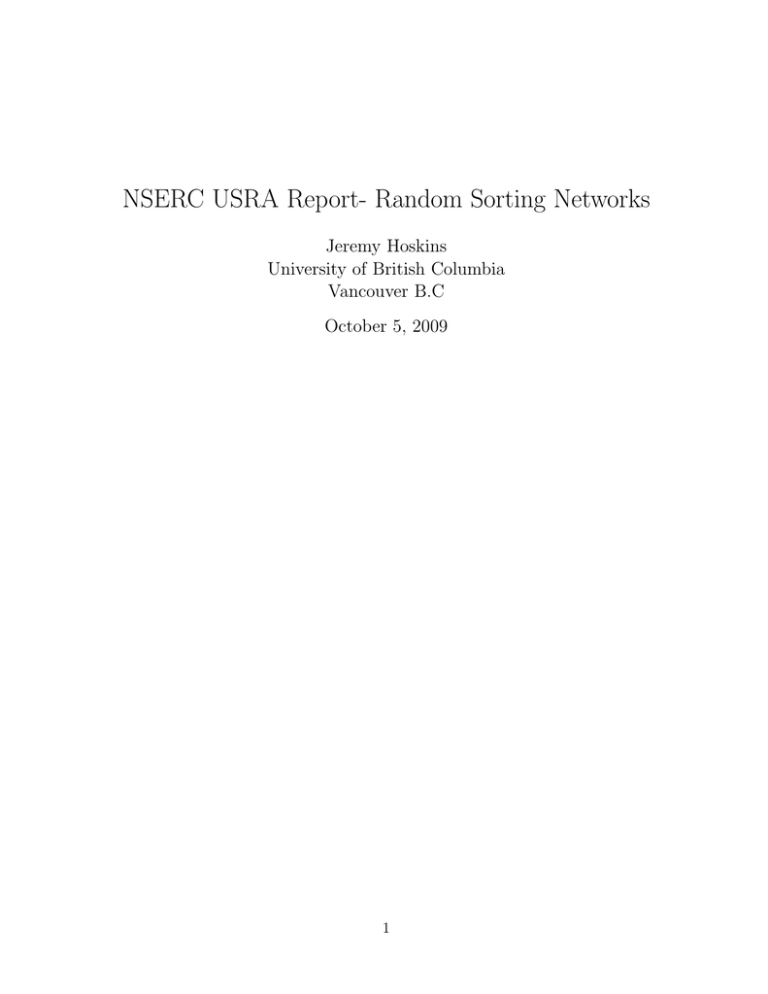
NSERC USRA Report- Random Sorting Networks
Jeremy Hoskins
University of British Columbia
Vancouver B.C
October 5, 2009
1
This summer, I studied the properties of random sorting networks with Dr. Omer Angel.
A sorting network of n elements is a way of transforming the ordered set {1, 2, ..., n} to the
reverse-ordered set {n, n − 1, ..., 1} through a series of adjacent transpositions of elements.
For example, one 4 element sorting network is,
{1, 2, 3, 4} → {2, 1, 3, 4} → {2, 3, 1, 4} → {2, 3, 4, 1} → {2, 4, 3, 1} → {4, 2, 3, 1} → {4, 3, 2, 1}
This may also be considered as a sequence of permutations of n elements from the identity
permutation to the reverse, where each permutation differs from the preceeding by a single
transposition of two adjacent numbers. By considering the position of a single element as
a function of ’time’, or progress through the network, one arrives at the trajectory
of a
n
particle. Furthermore, by introducing the appropriate scaling factors n and 2 of distance
and time, respectively, one gets the scaled trajectories. A random sorting network of size n
is a sorting network chosen uniformly at random from all possible, valid, sorting networks
with n elements.
The analysis uses two prior results[1]: the circular distribution of the probability density
function and the stationarity of swaps. It has been found that, as the number of elements
n becomes arbitrarily large, the distribution of the scaled position of the first swaps follows
a distribution of the form
8 q
x(1 − x).
P (x) =
πn
The stationarity of swaps guarantees that this distribution holds for every swap of the
sorting network, not simply for the first one. This is true since, for every sorting network,
another sorting network may be found such that the first swap of the new network is the
second swap of the original.
For this project, a stochastic model was developed for the particle trajectories showing
heuristically that the limiting trajectories of random sorting networks approach sine curves
with a range of amplitudes and phases. This model was generated with the following
assumptions: the swap locations are truly independent and they follow the above circular
distribution. Furthermore, for the sake of the model, each particle’s path will be considered
to be independent of all other particle’s movements. With these simplifications, and as
n → ∞, one arrives at the functional, dependent upon the position x and the total number
of swaps y that a particle has made as:
P(x, y) ∼ c exp −n
Z 1
0
x0 (t) + y 0 (t)
4
0
β − y (t) log β +
log [x0 (t) + y 0 (t)]
π
2
y 0 (t) − x0 (t)
log [y 0 (t) − x0 (t)] dt.
+
2
!
Using standard methods from the calculus of variations, this functional can be turned into
2
a differential equation, the solution to which is an extremum of the functional. A solution
to the corresponding equation is:
x(t) = sin (ωt + δ).
This result yielded the expected sinusoidal behaviour, but interestingly, not with all the
desired properties, namely, an arbitrary amplitude. This suggests that a more complicated
model, which takes into account interactions between the particles, should be considered.
Work was also done in studying the bijection which exists between random sorting
networks and staircase Young tableaux. In particular, possible configurations for entries
along the diagonal of a staircase tableau were studied. A formula for the probability of
a given shape in the Young tableaux occurring, or a particular configuration forming,
was determined. It was found that for a given set S of distinct shapes λ within a given
configuration, at scaled position y,
P ≈
Y
λ∈S
λ
i−λ
q
|λ| Y
Yi
22|λ|
λi λ[i+λi −l+1]
1
2
2
1
−
ȳ
1
−
|λ|!
[
]
(λ
)[
i
[i+λi −l+1] )2 ]
2λi
λi
2 − (λi +λ
n|λ|
Γ(
+
1)
χ
l=1
λi ∈λ
λi
2
4
Y
Y
Y
[1 +
λi ,λj ∈S i<j rowsλk ∈λi colsλl ∈λj
j
i
2|λki ||λlj |
,
∆[∆ − (|λki | + |λlj |)]]
where ∆ is approximately twice the difference between the elements. The next step would
be to use this equation to determine the limiting shape and positional distribution of the
sub-tableaux elements.
References
[1] Omer Angel, Alexander E. Holroyd, Dan Romik, and Balint Virag. Random sorting
networks, 2006.
3
